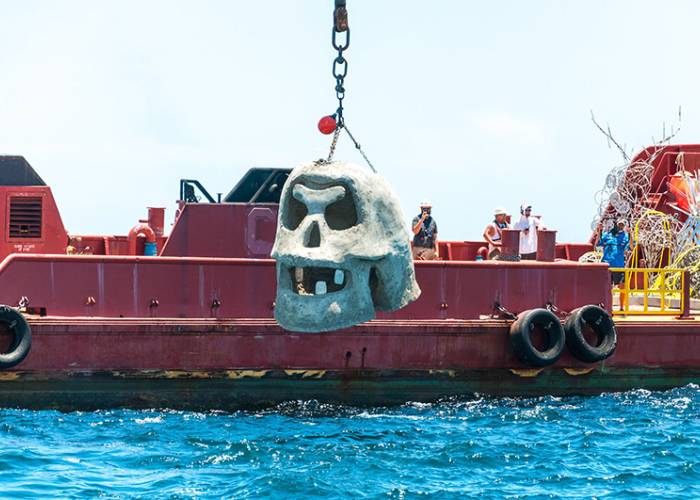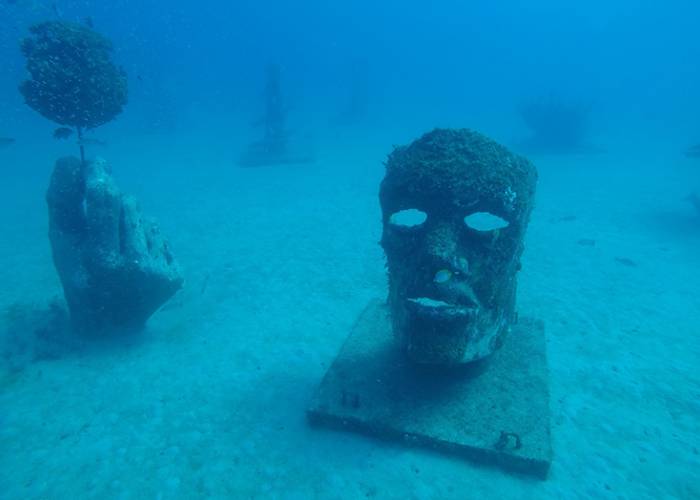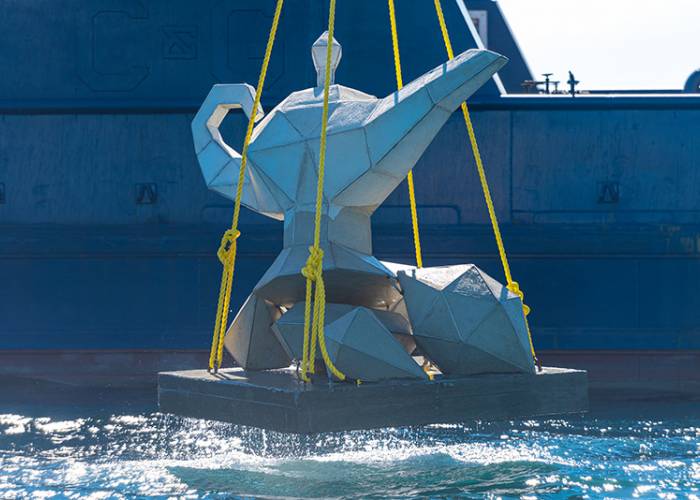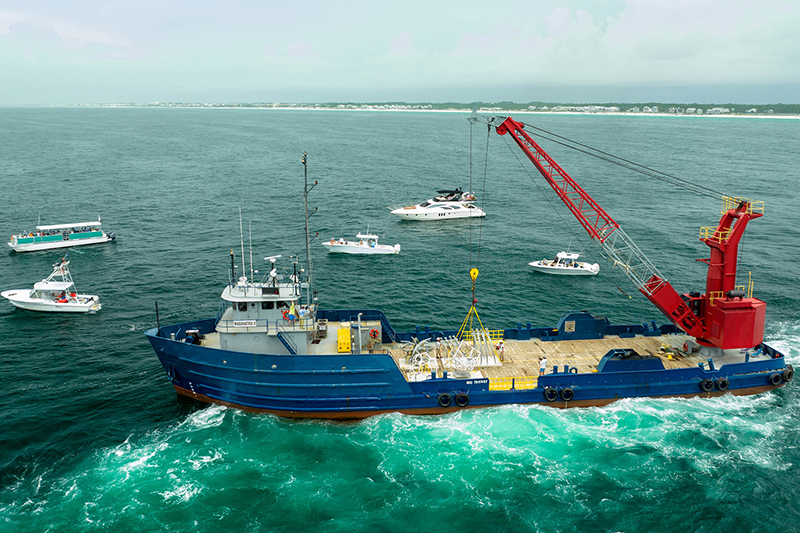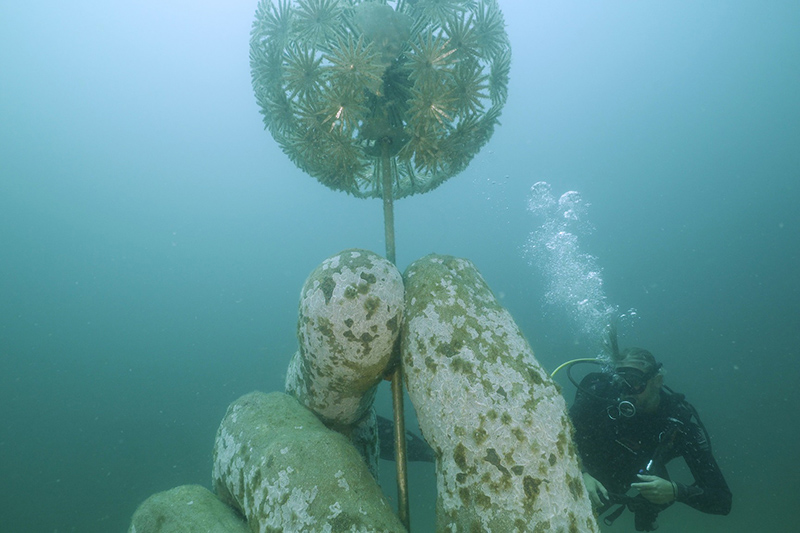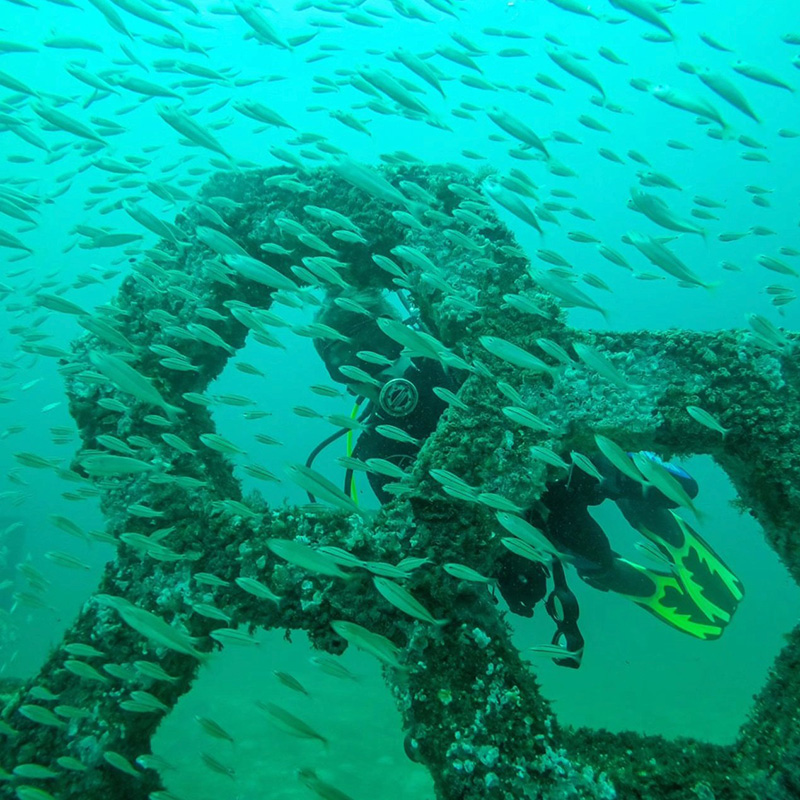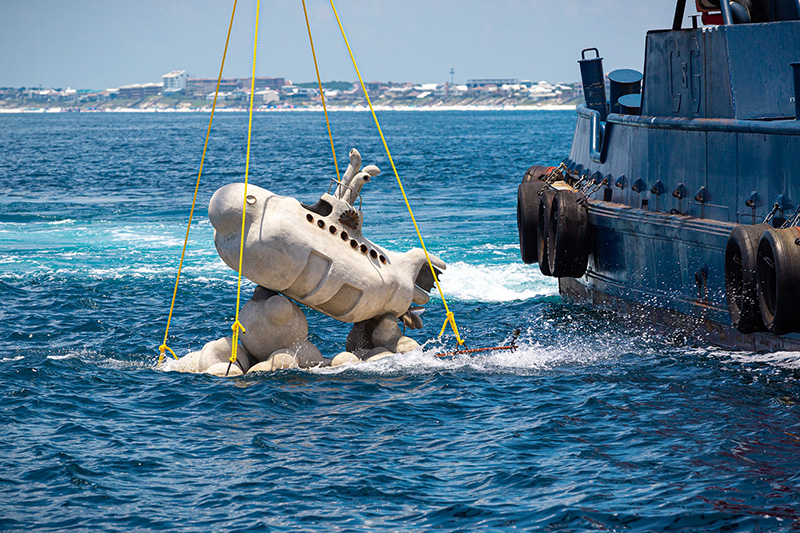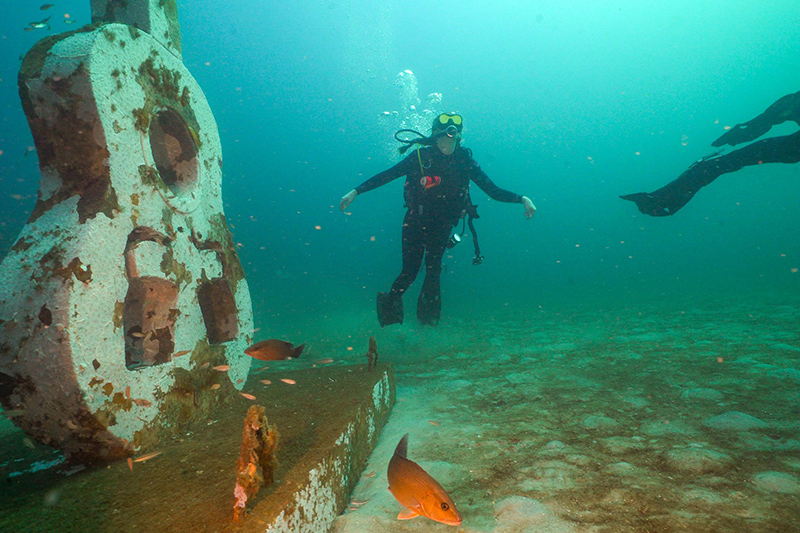The Underwater Museum of Art (UMA) is a unique 30A treasure and hidden world incorporating artistic sculptures as artificial reefs. UMA is the first and only underwater permanent sculpture exhibit in the United States. The site combines art with conservation, building marine life sanctuaries right off the coast.
This unique museum is an underwater sculpture garden located in the Gulf of Mexico at a depth of 58 feet and a distance of .93 miles from the shore of Grayton Beach State Park. Admission is free for divers to enjoy an attraction that is the perfect mix of art and ecological beauty. The submerged sculptures act as a habitat for local marine life creating a wonder of exploration. These artistic sculptures, elaborate reefs, and tropical fish create a museum-viewing experience like no other. Pictured above is a deployment of artwork into the Underwater Museum.
Cooperation Among Local and State Groups made UMA Possible
In 2018, the Cultural Arts Alliance of Walton County (CAA) partnered with the South Walton Artificial Reef Association (SWARA), and the Underwater Museum of Art was born, combining the love of the arts and the Gulf of Mexico. The UMA was founded with the mission of creating marine habitat, expanding fishery populations and providing enhanced creative, cultural, economic and educational opportunities for the benefit, education and enjoyment of residents, students and visitors in Walton County.
Underwater exhibits have Different Themes, Great Stories to Tell
The Underwater Museum of Art has a collection of artistic sculptures that range in theme and each piece tells a story. In this underwater world, you will find “Poseidon’s Throne,” a symbol of power, with areas for ocean life to inhabit and move throughout it, symbolizing that we must work together for our worlds to coexist. The sculpture of a large guitar “A Common Chord,” is a celebration of the natural beauty that surrounds and brings us together.
“Three Wishes” is a magical genie lamp statue that is interactive with marine life and divers alike. The lamp has a few small ports, which a diver can purge air from their octopus regulator, entering the lamp, and can be carried to the spout of the lamp where it emerges like a genie. “I Found It,” a giant diamond ring representing a lost treasure sits at the bottom of the Gulf. A giant octopus, a gigantic skull, a lifesize seashell, and a pirate shipwreck are among others that adorn the sea floor. You can see all of the artwork at the UMA website's interactive map along with information about the artists who created the underwater sculptures.
Artificial Reefs Support Marine Life
Artificial reefs are man-made structures that are designed to promote the growth of marine life. They are usually made out of concrete, metal, or stone, and they are often used to create artificial habitats for fish and other creatures. The many sculptures in the Underwater Museum actually create artificial reefs and are made with materials fitting of an artificial reef.
In addition to attracting fish, artificial reefs can also help to promote biodiversity by providing homes for a variety of other marine creatures. By promoting the growth of marine life, artificial reefs play an important role in the health of our oceans. Currently, Gulf coastal waters off Walton County are 95% barren sand flats. Deployment of sculpture as artificial reefs provides a source of biological replenishment and protective marine habitat where none exists.
It's the perfect place for small fish and invertebrate species to reproduce because the sculptures provide structure. The baitfish that are attracted to the sculptures bring with them larger predators, helping to keep the ecosystem in balance. Furthermore, UMA offers juvenile fish a secure environment in which to develop and mature before entering the open ocean.
The sculptures quickly attract a wide variety of marine life and, over time, transform into a living reef. It provides a much-needed habitat for local marine life. Marine scientists, wildlife management professionals, ecologists, and students, are given an opportunity to study marine life and measure the impact of artificial reef systems on the gulf ecosystem at this thriving eco attraction.
Hundreds of species have been observed at the Underwater Museum of Art.
Since it was launched in 2018, more than one hundred species of animal and plant life have been observed and documented from mammals to reptiles, fish and invertebrates, and the numbers of sea life are growing annually. Dolphins and sea turtles have been spotted regularly in this underwater playground. Several species of tropical fish and invertebrates call this new underwater place home. The museum is a popular spot for scuba divers to enjoy this vast array of underwater life.
UMA Receives Critical Acclaim and Exposure
The Underwater Museum of Art has been featured in the New York Times, National Geographic, Newsweek, CNN Travel, and countless other publications. Time Magazine named UMA on the list of World’s Greatest Places to Visit. The museum also has a five-star review by visitors who have explored it.
New statues are added annually with an elaborate call for artists
Each year there is a call for artists to create and deploy their works of art. The process is an elaborate one that includes the creation, structural integrity, transportation, and deployment of the statute. There are specific materials and methods required to create art that will survive an underwater environment and promote healthy ecological environments. There is even a turtle trap escape requirement to ensure sea turtles can safely navigate the statues.
National, regional, and local artists exhibit their work at this underwater museum. Local artist Elise Gilbert, who lives locally in Santa Rosa Beach, Florida, and works with the CAA of Walton County shows her art at the Underwater Museum. Environmental artist Beatriz Chachamovits displays her work at the Underwater Museum with her work recently featured in Vogue Magazine’s Earth and Us section and the National Geographic Education platform. These are just some of the talented artists who submit their work in the Underwater Museum.
The Underwater Statues Can be Viewed by Certified Divers
Visitors who wish to experience the site should be certified divers who are comfortable swimming in open water. Divers who wish to visit the site can take a dive boat 0.7 miles off the coast of Grayton Beach State Park. You can book an excursion through Dive30A for this unique scuba diving experience.
Visit the Underwater Museum of Art in Grayton Beach, Florida
The Underwater Museum of Art combines the love of art and nature to create a diving experience like no other, all just off the coast of Grayton Beach State Park in northwest Florida in the 30A corridor. Not only is this a unique experience, it is the only one in America. Check out the Underwater Museum of Art Florida’s website to see more about this unique attraction including a map of the exhibits, how to submit sculptures, and more.
(Photos used in this article are from the Underwater Museum of Art website and Facebook page. All rights reserved.)
